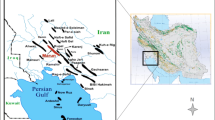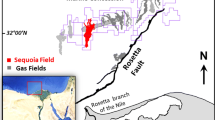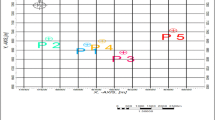Abstract
Extracting reservoir properties from a 3D seismic cube is an extremely sensitive job. While the inversion procedure for obtaining the inverted seismic data is itself an important step, most of such sensitivity contributes with applying multi-attribute transforms on an inverted cube to obtain a cube of reservoir property. A multi-attribute transform was applied on a 3D seismic data of a gentle anticline located southwest of Iran. Few well logs from the full sets were missing which were estimated using neural networks with sufficiently large correlations. An extended study was performed to extract the most suitable wavelet from the seismic data. The 3D cube was inverted using the model-based inversion method. The inverted cube along with other extracted cubes of seismic attributes was used as inputs to neural networks to estimate reservoir properties. Various attribute lists and estimation methods were applied and studied, and the best set of attributes and the best method of estimation were introduced. Porosity distribution was responsible for pressure difference across the reservoir; pressure communication between two upper zones was approved; results demonstrated a new potential hydrocarbon-bearing layer separated from the above producing layer by a nonporous layer. The existence of such a potential was approved by drilling a new well. The extent of reservoir flooded by the injected gas was demonstrated.










Similar content being viewed by others
References
Aanonsen SI, Aavatsmark I, Barkve T, Cominelli A, Gonard R, Gosselin O, Kolasinski M, Reme H (2003) Effect of scale dependent data correlations in an integrated history matching loop combining production data and 4D seismic data, SPE 79665, SPE Reservoir Simulation Symp. Houston, USA, 3–5 February
Alpaydin E (2010) Introduction to machine learning. Massachusetts Institute of Technology, Cambridge
Aster RC, Borchers B, Thurber CH (2005) Parameter estimation and inverse problems. Elsevier, New York
Bishop CM (2006) Pattern recognition and machine learning. Springer Science+Business Media, Berlin
Boadu F (1998) Inversion of fracture density from field seismic velocities using artificial neural networks. Geophysics 63:534–545
Dai H, MacBeth C (1994) Split shear-wave analysis using an artificial neural network. First Break 12:605–613
Dorrington KP, Link CA (2004) Genetic-algorithm/neural-network approach to seismic attribute selection for well-log prediction. Geophysics 69(1):212–221
FitzGerald E, Bean C, Reilly R (1999) Fracture-frequency prediction from borehole wireline logs using artificial neural networks. Geophys Prospect 47:1031–1044
Gosselin O, van den Berg S, Cominelli A (2001) Integrated history-matching of production and 4D Seismic Data. Paper SPE 71599, presented at the 2001 SPE Annual Technical Conference and Exhibition, New Orleans, Louisiana, 30 Sept–3 Oct 2001
Gosselin O, Aanonsen SI, Aavatsmark I, Cominelli A, Gonard R, Kolasinski M, Ferdinandi F, Kovacic L, Neylon K (2003) History matching using time-lapse seismic (HUTS), SPE 84464, SPE Reservoir Simulation Symp, Denver, USA, 5–8 October
Hampson DP, Schuelke JS, Quirein JA (2001) Use of multiattribute transforms to predict log properties from seismic data. Geophysics 66(1):220–236
Hosseini M (2006) Uncertainty assessment of reservoir production prediction in one of Iranian gas fields; MSc. Thesis; University of Petroleum Technology
Leggett M, Sandham W, Durrani T (1996) 3-D horizon tracking using artificial neural networks. First Break 14:413–418
Liu Z, Liu J (1998) Seismic-controlled nonlinear extrapolation of well parameters using neural networks. Geophysics 63:2035–2041
Mitchel TM (1997) Machine learning. McGraw-Hill Science/Engineering/Math, New York
Nikravesh M, Aminzadeh F, Zadeh LA (2003) Soft computing and intelligent data analysis in oil exploration. Elsevier, New York
Poulton MM (2002) Neural networks as an intelligence amplification tool: a review of applications. Geophysics 67(3):979–993
Roth G, Tarantola A (1991) Use of neural networks for inversion of seismic data. In: 61st Annual International Meeting, Society of Exploration Geophysicists, pp 302–305
Roth G, Tarantola A (1994) Neural networks and inversion of seismic data. J Geophys Res 99:6753–6768
Russell B, Hampson D (1991) A comparison of post-stack seismic inversion methods. 61st Annual International Meeting, SEG, Expanded Abstracts, pp 876–878
Sams M, Saussus D (2008) Comparison of uncertainty estimates from deterministic and geostatistical inversion. 78th Annual International Meeting, SEG, Expanded Abstracts, 27, pp 1486–1489
Sayers CM (2010) Geophysics under stress: geomechanical application of seismic and borehole acoustic waves. Society of Exploration Geophysicists, Tulsa
Stark PB, Parker RL (1995) Bounded-variable least-squares: an algorithm and applications. Comput Stat 10(2):129–141
Tarantola A (1987) Inverse problem theory—methods for data fitting and model parameter estimation. Elsevier Science Publ. Co., New York
Theodoridis S, Koutroumbas K (2003) Pattern recognition. Elsevier Academic Press, Cambridge
van der Baan M, Jutten C (2000) Neural networks in geophysical applications. Geophysics 65:1032–1047
Veezhinathan J, Wagner D, Ehlers J (1991) First break picking using a neural network. In: Aminzadeh F, Simaan M (eds) Expert systems in exploration. Society of Exploration Geophysicists, Tulsa, pp 179–202
Web A (2002) Statistical pattern recognition. Wiley, Berlin
Acknowledgements
The authors would like to acknowledge Institute of Geophysics at University of Tehran and the Electronics Department at the Engineering School of the University of Tehran for their collaborative aid in providing scientific material to this work. We also greatly appreciate the Geophysics Division of the NISOC for providing data and field information to this project.
Author information
Authors and Affiliations
Corresponding author
Additional information
Publisher's Note
Springer Nature remains neutral with regard to jurisdictional claims in published maps and institutional affiliations.
Rights and permissions
About this article
Cite this article
Hosseini, M., Riahi, M.A. Detecting a gas injection front using a 3D seismic data: case of an Asmari carbonate reservoir in the Zagros basin. Carbonates Evaporites 34, 1657–1668 (2019). https://doi.org/10.1007/s13146-019-00514-2
Accepted:
Published:
Issue Date:
DOI: https://doi.org/10.1007/s13146-019-00514-2




